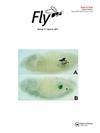黑腹果蝇正在发育的翅膀横静脉:一个迷人的信号传导和形态发生模型
IF 2.2
4区 生物学
Q3 BIOCHEMISTRY & MOLECULAR BIOLOGY
引用次数: 3
摘要
摘要:果蝇翅膀已被用作研究组织生长、形态发生和模式形成的模型。果蝇的翼脉由两种不同的结构组成,纵脉和横脉。尽管在幼虫阶段,纵静脉的位置信息在很大程度上是在翅膀想象盘中确定的,但横静脉原始细胞在蛹早期之前似乎是幼稚的。在这里,我们首先回顾一下过去是如何研究机翼横静脉的。然后,总结了横脉形成的发育机制。这篇综述的重点是BMP配体的保守运输机制如何用于横静脉形成,以及各种辅助因子如何在维持BMP信号传导中发挥作用。最近的研究结果进一步表明,交叉静脉发育是解决BMP信号和动态细胞过程如何耦合的极好模型。这篇全面的综述说明了机翼横静脉发展模型的独特性、科学价值和未来前景。本文章由计算机程序翻译,如有差异,请以英文原文为准。
The developing wing crossvein of Drosophila melanogaster: a fascinating model for signaling and morphogenesis
ABSTRACT The Drosophila wing has been used as a model for studying tissue growth, morphogenesis and pattern formation. The wing veins of Drosophila are composed of two distinct structures, longitudinal veins and crossveins. Although positional information of longitudinal veins is largely defined in the wing imaginal disc during the larval stage, crossvein primordial cells appear to be naive until the early pupal stage. Here, we first review how wing crossveins have been investigated in the past. Then, the developmental mechanisms underlying crossvein formation are summarized. This review focuses on how a conserved trafficking mechanism of BMP ligands is utilized for crossvein formation, and how various co-factors play roles in sustaining BMP signalling. Recent findings further reveal that crossvein development serves as an excellent model to address how BMP signal and dynamic cellular processes are coupled. This comprehensive review illustrates the uniqueness, scientific value and future perspectives of wing crossvein development as a model.
求助全文
通过发布文献求助,成功后即可免费获取论文全文。
去求助
来源期刊

Fly
生物-生化与分子生物学
CiteScore
2.90
自引率
0.00%
发文量
17
审稿时长
>12 weeks
期刊介绍:
Fly is the first international peer-reviewed journal to focus on Drosophila research. Fly covers a broad range of biological sub-disciplines, ranging from developmental biology and organogenesis to sensory neurobiology, circadian rhythm and learning and memory, to sex determination, evolutionary biology and speciation. We strive to become the “to go” resource for every researcher working with Drosophila by providing a forum where the specific interests of the Drosophila community can be discussed. With the advance of molecular technologies that enable researchers to manipulate genes and their functions in many other organisms, Fly is now also publishing papers that use other insect model systems used to investigate important biological questions.
Fly offers a variety of papers, including Original Research Articles, Methods and Technical Advances, Brief Communications, Reviews and Meeting Reports. In addition, Fly also features two unconventional types of contributions, Counterpoints and Extra View articles. Counterpoints are opinion pieces that critically discuss controversial papers questioning current paradigms, whether justified or not. Extra View articles, which generally are solicited by Fly editors, provide authors of important forthcoming papers published elsewhere an opportunity to expand on their original findings and discuss the broader impact of their discovery. Extra View authors are strongly encouraged to complement their published observations with additional data not included in the original paper or acquired subsequently.
 求助内容:
求助内容: 应助结果提醒方式:
应助结果提醒方式:


